外研版(2019)选择性必修 第一册Unit 6 Nurturing nature Starting out & Understanding ideas课件(共65张PPT,内镶嵌视频)
文档属性
| 名称 | 外研版(2019)选择性必修 第一册Unit 6 Nurturing nature Starting out & Understanding ideas课件(共65张PPT,内镶嵌视频) |  | |
| 格式 | pptx | ||
| 文件大小 | 70.8MB | ||
| 资源类型 | 教案 | ||
| 版本资源 | 外研版(2019) | ||
| 科目 | 英语 | ||
| 更新时间 | 2023-10-26 16:26:36 | ||
图片预览


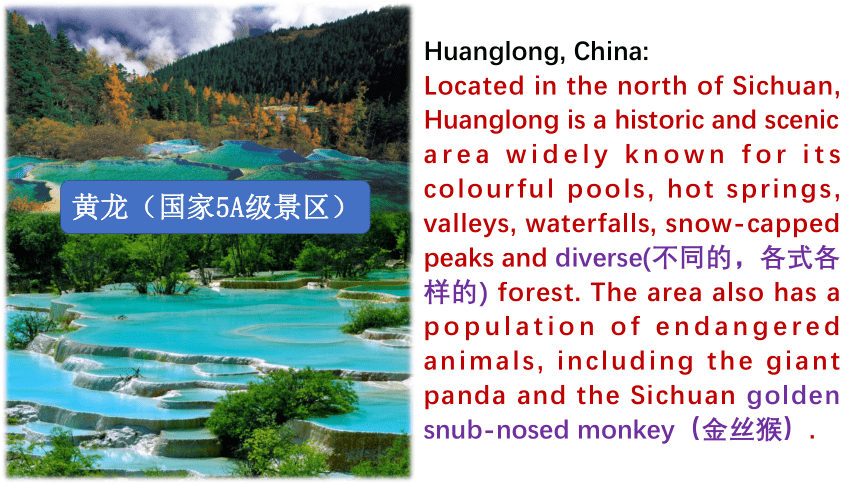
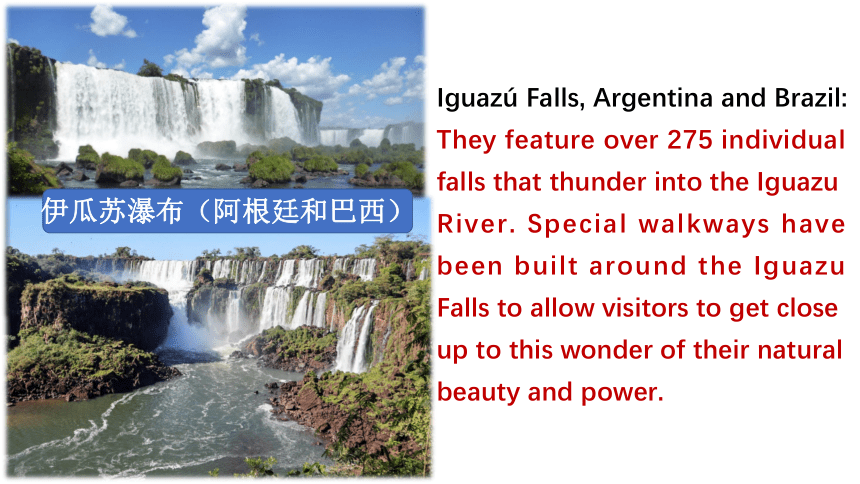
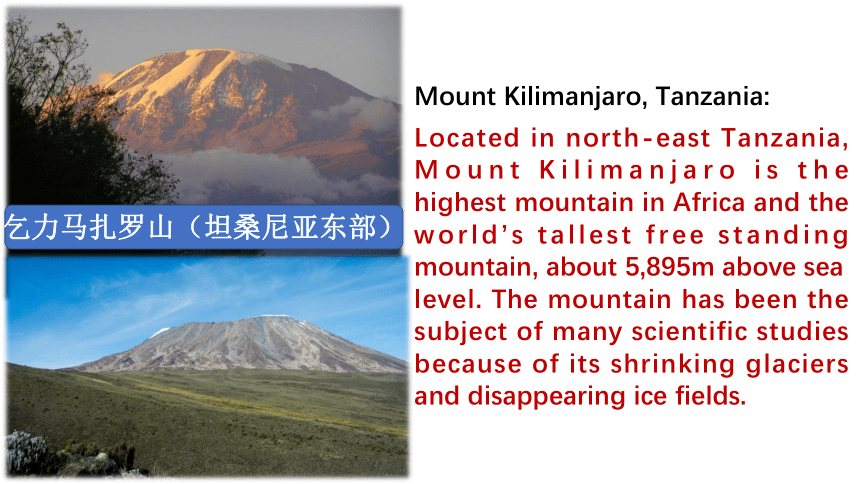
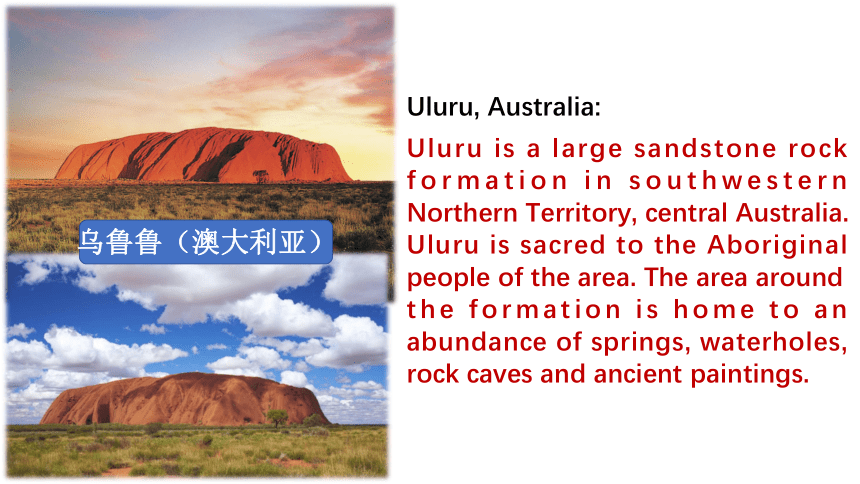



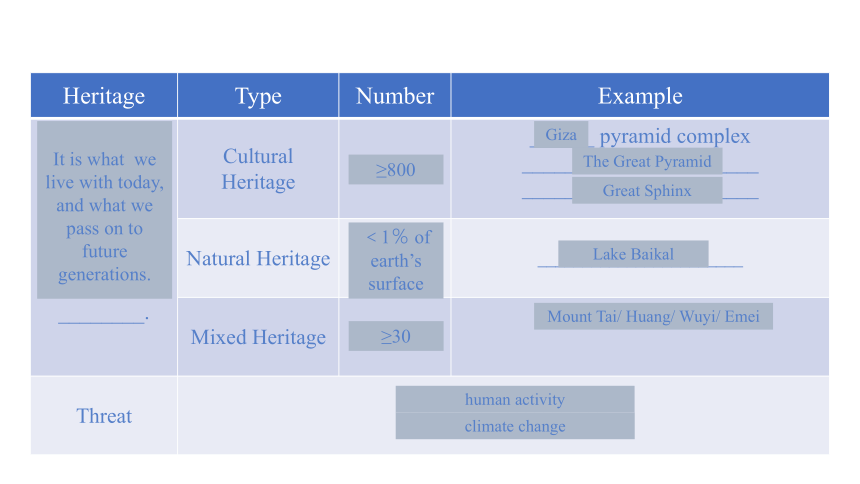

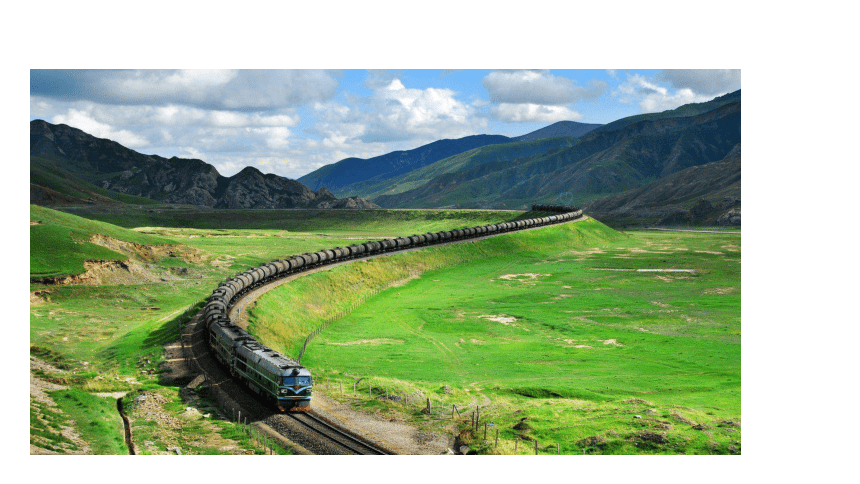
文档简介
(共65张PPT)
Unit 6 Nurturing Nature
Starting out
Look at the pictures and answer the questions.
1. What do you know about these places
2. What do these places have in common
黄龙(国家5A级景区)
Huanglong, China:
Located in the north of Sichuan, Huanglong is a historic and scenic area widely known for its colourful pools, hot springs, valleys, waterfalls, snow-capped peaks and diverse(不同的,各式各样的) forest. The area also has a population of endangered animals, including the giant panda and the Sichuan golden snub-nosed monkey(金丝猴).
伊瓜苏瀑布(阿根廷和巴西)
Iguazú Falls, Argentina and Brazil:
They feature over 275 individual falls that thunder into the Iguazu River. Special walkways have been built around the Iguazu Falls to allow visitors to get close up to this wonder of their natural beauty and power.
乞力马扎罗山(坦桑尼亚东部)
Mount Kilimanjaro, Tanzania:
Located in north-east Tanzania, Mount Kilimanjaro is the highest mountain in Africa and the world’s tallest free standing mountain, about 5,895m above sea level. The mountain has been the subject of many scientific studies because of its shrinking glaciers and disappearing ice fields.
乌鲁鲁(澳大利亚)
Uluru, Australia:
Uluru is a large sandstone rock formation in southwestern Northern Territory, central Australia. Uluru is sacred to the Aboriginal people of the area. The area around the formation is home to an abundance of springs, waterholes, rock caves and ancient paintings.
Now let’s watch a video.
After watching the video, answer the questions.
1.What is Heritage
2.What are the three types of World Heritage Sites
1.What is Heritage
Heritage is not only our legacy from the _____. It is what we ______ _____ today and what we _______ _______ to future generations.
past
live
with
pass
on
2.What are the three types of World Heritage Sites
World Heritage Sites are classified as _______________, _______________or_____________ .
cultural heritage
natural heritage
mixed heritage
Heritage Type Number Example
It is what ___________, and what ________________________________. Cultural Heritage ______ pyramid complex
______________________
______________________
Natural Heritage _______________________
Mixed Heritage ________________________
Threat _______________________ _______________________
It is what we live with today, and what we pass on to future generations.
≥800
<1% of earth’s surface
≥30
Giza
The Great Pyramid
Great Sphinx
Lake Baikal
Mount Tai/ Huang/ Wuyi/ Emei
human activity
climate change
Unit 6 Nurturing nature
Understanding ideas
Qinghai-tibet Railway (English name :Qinghai-Tibet Railway), short for Qingzang Railway, is a national Railway class I Railway connecting Xining city of Qinghai Province to Lhasa City of Tibet Autonomous Region. It is one of China's four major projects in the new century. It is the first Railway to the hinterland of Tibet, and also the highest altitude and longest plateau Railway in the world.
青藏铁路(英文名称:Qinghai-Tibet Railway),简称青藏线,是一条连接青海省西宁市至西藏自治区拉萨市的国铁Ⅰ级铁路,是中国新世纪四大工程之一,是通往西藏腹地的第一条铁路,也是世界上海拔最高、线路最长的高原铁路。
The qinghai-Tibet Railway was completed in two phases. The first phase of the railway started in 1958 from Xining city in Qinghai Province to Golmud city in the west and was opened to traffic in May 1984.The second phase of the project, starting from Golmud of Qinghai Province in the east and ending in Lhasa of Tibet Autonomous Region in the west, began construction on June 29, 2001 and opened to traffic on July 1, 2006.
青藏铁路分两期建成,一期工程东起青海省西宁市,西至格尔木市,于1958年开工建设,1984年5月建成通车;二期工程,东起青海省格尔木市,西至西藏自治区拉萨市,于2001年6月29日开工,2006年7月1日全线通车。
Qinghai-tibet Railway from Xining station to Lhasa station;The total length of the line is 1,956 kilometers, including 814 kilometers from Xining to Golmud, and 1,142 kilometers from Golmud to Lhasa.There are a total of 85 stations with a designed maximum speed of 160 km/h (Xining to Golmud) and 100 km/h (Golmud to Lhasa).As of March 2015, the qinghai-Tibet Railway operates at 140 km/h (xining to Golmud) and 100 km/h (Golmud to Lhasa).
青藏铁路由西宁站至拉萨站;线路全长1956千米,其中西宁至格尔木段814千米,格尔木至拉萨段全长1142千米;共设85个车站,设计的最高速度为160千米/小时(西宁至格尔木段)、100千米/小时(格尔木至拉萨段)。截至2015年3月,青藏铁路的运营速度为140千米/小时(西宁至格尔木段)、100千米/小时(格尔木至拉萨段)。
Complete the quiz.
Which is the highest railway in the world
a. The Trans-Siberian Railway.
b. The Qinghai-Tibet Railway
c. The Chengdu-Kunming Railway
2. In which year was the completed Qinghai-Tibet Railway put into operation
a. 1984 b. 2001 c. 2006
3. Which of these stations is not on the Qinghai-Tibet Railway
a. Lhasa. b. Golmud c. Lanzhou
4. Which of these natural World Heritage Sites does the Qinghai-Tibet Railway pass by
a. Xinjiang Tianshan.
b. Qinghai Hoh Xil.
c. South China Karst.
Now let’s watch a video about the Qinghai-Tibet Railway.
1. To prove that humans can conquer nature.
2. To highlight the amount of work required to build the Qinghai-Tibet Railway.
3. To praise the workers' efforts in building the Qinghai-Tibet Railway.
Choose the author's purpose in writing the passage.
Read the passage and match the main idea to each part.
A. I am proud of the Qinghai-Tibet Railway.
B. Why we built some bridges.
C. While building the great railway,we managed to protect the protect ecosystem.
D.I was about to travel along the Qinghai-Tibet Railway.
E. What was done to protect railway workers.
F. What was done to protect Cuona Lake.
Para. 1
Para. 2
Para. 3-4
Para. 5
Para. 6
Para. 7
Thirty-three passages
move safely and freely in their natural habitat
prevent damage to wetlands and grasslands
a total length of about 160 kilometres
moved to a new area
Several oxygen-making stations
regular breaks
protect Cuona Lake
build a twenty-kilometre wall
protect it from construction waste
Unit 6 Nurturing Nature
Starting out
Look at the pictures and answer the questions.
1. What do you know about these places
2. What do these places have in common
黄龙(国家5A级景区)
Huanglong, China:
Located in the north of Sichuan, Huanglong is a historic and scenic area widely known for its colourful pools, hot springs, valleys, waterfalls, snow-capped peaks and diverse(不同的,各式各样的) forest. The area also has a population of endangered animals, including the giant panda and the Sichuan golden snub-nosed monkey(金丝猴).
伊瓜苏瀑布(阿根廷和巴西)
Iguazú Falls, Argentina and Brazil:
They feature over 275 individual falls that thunder into the Iguazu River. Special walkways have been built around the Iguazu Falls to allow visitors to get close up to this wonder of their natural beauty and power.
乞力马扎罗山(坦桑尼亚东部)
Mount Kilimanjaro, Tanzania:
Located in north-east Tanzania, Mount Kilimanjaro is the highest mountain in Africa and the world’s tallest free standing mountain, about 5,895m above sea level. The mountain has been the subject of many scientific studies because of its shrinking glaciers and disappearing ice fields.
乌鲁鲁(澳大利亚)
Uluru, Australia:
Uluru is a large sandstone rock formation in southwestern Northern Territory, central Australia. Uluru is sacred to the Aboriginal people of the area. The area around the formation is home to an abundance of springs, waterholes, rock caves and ancient paintings.
Now let’s watch a video.
After watching the video, answer the questions.
1.What is Heritage
2.What are the three types of World Heritage Sites
1.What is Heritage
Heritage is not only our legacy from the _____. It is what we ______ _____ today and what we _______ _______ to future generations.
past
live
with
pass
on
2.What are the three types of World Heritage Sites
World Heritage Sites are classified as _______________, _______________or_____________ .
cultural heritage
natural heritage
mixed heritage
Heritage Type Number Example
It is what ___________, and what ________________________________. Cultural Heritage ______ pyramid complex
______________________
______________________
Natural Heritage _______________________
Mixed Heritage ________________________
Threat _______________________ _______________________
It is what we live with today, and what we pass on to future generations.
≥800
<1% of earth’s surface
≥30
Giza
The Great Pyramid
Great Sphinx
Lake Baikal
Mount Tai/ Huang/ Wuyi/ Emei
human activity
climate change
Unit 6 Nurturing nature
Understanding ideas
Qinghai-tibet Railway (English name :Qinghai-Tibet Railway), short for Qingzang Railway, is a national Railway class I Railway connecting Xining city of Qinghai Province to Lhasa City of Tibet Autonomous Region. It is one of China's four major projects in the new century. It is the first Railway to the hinterland of Tibet, and also the highest altitude and longest plateau Railway in the world.
青藏铁路(英文名称:Qinghai-Tibet Railway),简称青藏线,是一条连接青海省西宁市至西藏自治区拉萨市的国铁Ⅰ级铁路,是中国新世纪四大工程之一,是通往西藏腹地的第一条铁路,也是世界上海拔最高、线路最长的高原铁路。
The qinghai-Tibet Railway was completed in two phases. The first phase of the railway started in 1958 from Xining city in Qinghai Province to Golmud city in the west and was opened to traffic in May 1984.The second phase of the project, starting from Golmud of Qinghai Province in the east and ending in Lhasa of Tibet Autonomous Region in the west, began construction on June 29, 2001 and opened to traffic on July 1, 2006.
青藏铁路分两期建成,一期工程东起青海省西宁市,西至格尔木市,于1958年开工建设,1984年5月建成通车;二期工程,东起青海省格尔木市,西至西藏自治区拉萨市,于2001年6月29日开工,2006年7月1日全线通车。
Qinghai-tibet Railway from Xining station to Lhasa station;The total length of the line is 1,956 kilometers, including 814 kilometers from Xining to Golmud, and 1,142 kilometers from Golmud to Lhasa.There are a total of 85 stations with a designed maximum speed of 160 km/h (Xining to Golmud) and 100 km/h (Golmud to Lhasa).As of March 2015, the qinghai-Tibet Railway operates at 140 km/h (xining to Golmud) and 100 km/h (Golmud to Lhasa).
青藏铁路由西宁站至拉萨站;线路全长1956千米,其中西宁至格尔木段814千米,格尔木至拉萨段全长1142千米;共设85个车站,设计的最高速度为160千米/小时(西宁至格尔木段)、100千米/小时(格尔木至拉萨段)。截至2015年3月,青藏铁路的运营速度为140千米/小时(西宁至格尔木段)、100千米/小时(格尔木至拉萨段)。
Complete the quiz.
Which is the highest railway in the world
a. The Trans-Siberian Railway.
b. The Qinghai-Tibet Railway
c. The Chengdu-Kunming Railway
2. In which year was the completed Qinghai-Tibet Railway put into operation
a. 1984 b. 2001 c. 2006
3. Which of these stations is not on the Qinghai-Tibet Railway
a. Lhasa. b. Golmud c. Lanzhou
4. Which of these natural World Heritage Sites does the Qinghai-Tibet Railway pass by
a. Xinjiang Tianshan.
b. Qinghai Hoh Xil.
c. South China Karst.
Now let’s watch a video about the Qinghai-Tibet Railway.
1. To prove that humans can conquer nature.
2. To highlight the amount of work required to build the Qinghai-Tibet Railway.
3. To praise the workers' efforts in building the Qinghai-Tibet Railway.
Choose the author's purpose in writing the passage.
Read the passage and match the main idea to each part.
A. I am proud of the Qinghai-Tibet Railway.
B. Why we built some bridges.
C. While building the great railway,we managed to protect the protect ecosystem.
D.I was about to travel along the Qinghai-Tibet Railway.
E. What was done to protect railway workers.
F. What was done to protect Cuona Lake.
Para. 1
Para. 2
Para. 3-4
Para. 5
Para. 6
Para. 7
Thirty-three passages
move safely and freely in their natural habitat
prevent damage to wetlands and grasslands
a total length of about 160 kilometres
moved to a new area
Several oxygen-making stations
regular breaks
protect Cuona Lake
build a twenty-kilometre wall
protect it from construction waste
